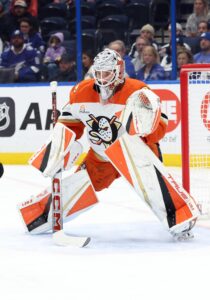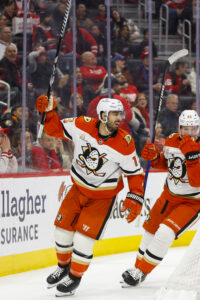Free agency is just over a month away, and teams are looking ahead to when it opens. There will be several impact players set to hit the open market in July, while many teams also have key restricted free agents to re-sign. We start our look around the NHL with an overview of the free agent situation for the Ducks.
Key Restricted Free Agents
 G Lukas Dostal – Dostal had been viewed as Anaheim’s goalie of the future for some time now. He rewarded the franchise’s faith in spades with a breakout 2024-25 campaign. Now entirely supplanting John Gibson as the team’s No. 1 option between the pipes, his numbers slipped a bit down the stretch but still managed a 23-23-7 record, a .903 SV%, a 3.10 GAA, and one shutout in a career-high 54 appearances behind one of the league’s worst defensive teams. He’s owed a qualifying offer of just $892.5K coming off a cheap partial two-way deal, but will land much more than that on his coming deal, especially with arbitration rights in his back pocket. A one-year bridge likely keeps Dostal in the $4MM range, but for a Ducks club with ample salary cap flexibility, general manager Pat Verbeek could award him something in the $5MM-$6MM range on a mid-term deal if they’re unprepared to go eight years.
G Lukas Dostal – Dostal had been viewed as Anaheim’s goalie of the future for some time now. He rewarded the franchise’s faith in spades with a breakout 2024-25 campaign. Now entirely supplanting John Gibson as the team’s No. 1 option between the pipes, his numbers slipped a bit down the stretch but still managed a 23-23-7 record, a .903 SV%, a 3.10 GAA, and one shutout in a career-high 54 appearances behind one of the league’s worst defensive teams. He’s owed a qualifying offer of just $892.5K coming off a cheap partial two-way deal, but will land much more than that on his coming deal, especially with arbitration rights in his back pocket. A one-year bridge likely keeps Dostal in the $4MM range, but for a Ducks club with ample salary cap flexibility, general manager Pat Verbeek could award him something in the $5MM-$6MM range on a mid-term deal if they’re unprepared to go eight years.
F Mason McTavish – McTavish’s game has steadily improved since being drafted third overall in 2021, and this season was no different. While the 22-year-old was robbed of a full 82-game schedule due to a few here-and-there injuries, he still set career-highs with 22 goals, 30 assists, and 52 points in 76 appearances. Now a legitimate top-six center with still room to grow, he’ll significantly outpace the $874,125 qualifying offer he’s owed as he comes off his entry-level deal. A deal in the $4MM range on a shorter-term commitment seems apt if the Ducks are still uncertain about his ceiling. Still, with his linear development so far, he could earn a long-term deal approaching the $7MM mark to lock him in as Anaheim’s No. 2 center behind Leo Carlsson long-term.
F Isac Lundestrom – A first-round pick back in 2018, Lundestrom’s role hasn’t fluctuated much since establishing himself as a full-timer in the shortened 2020-21 campaign. His ice time has steadily decreased as the player they once thought could be a long-term, defensively responsible third-line pivot hasn’t produced the level of offense they’d like for that role. 2024-25 was Lundestrom’s worst offensive performance of his five-year run as a full-time NHLer at just 0.19 points per game (4-11–15 in 79 GP). That’s not to say he’s not valuable – he’s one of the Ducks’ top penalty killers, and his possession metrics this season were passable given his extended defensive zone deployment at 5-on-5. Still, he’s likely more of a high-end fourth-line option long-term than a third-line one. It wouldn’t be surprising to see him accept his $1.5MM qualifying offer as a result, or take a multi-year deal in that range annually to gain some added stability in Anaheim if he desires.
F Brett Leason – Claimed off waivers from the Capitals at the beginning of the 2022-23 season, Leason capped off his third year in Anaheim with nine healthy scratches in 12 games. He was still serviceable in bottom-six minutes, scoring 17 points in 62 games with a minus-two rating in similarly heavy defensive deployment to Lundestrom. Still, he’s at risk of being non-tendered for the second consecutive year. Of course, he signed a one-year, $1.05MM contract on the first day of free agency to return to the Ducks despite not receiving a qualifying offer, but his willingness to do so again may be diminished after his lack of usage to end the campaign.
D Drew Helleson – Helleson, 23, somewhat surprisingly emerged as a roster fixture this year. He didn’t play anywhere close to a full schedule, suiting up 56 times, but remained on the Ducks’ roster for the balance of the season after being recalled from AHL San Diego in mid-November. The 6’3″, 214-lb righty did better than most would have expected given his limited minor-league success, posting 13 points and a plus-six rating in bottom-pairing minutes (16:21 ATOI). A 2019 second-round pick of the Avalanche who was acquired for Josh Manson in 2022, Helleson’s likely earned an opening-night job in the fall. He could even challenge Jacob Trouba for top-four minutes next year since the latter was a non-factor after his early-season acquisition from the Rangers.
Other RFAs: F Judd Caulfield, G Calle Clang, F Sam Colangelo, F Josh Lopina, F Jan Mysak, F Nikita Nesterenko, F Tim Washe
Key Unrestricted Free Agents
 F Robby Fabbri – When healthy, Fabbri has been a decent secondary scorer throughout his nine-year NHL career. However, injuries have been a constant, and this year was no different. Knee surgery and a hand injury took away nearly half of his 2024-25 campaign, and he ended the year with an 8-8–16 scoring line in 44 contests. The 29-year-old has still hit at least 30 points twice in the last four years despite significant absences, which should help his case on the open market. With 2024 No. 3 overall pick Beckett Sennecke pushing for an opening-night job and the Ducks likely to be active in free agency, though, there may not be a fit for him on next year’s team. If they want to retain him, his injury concerns should make him a low-cost pickup around $1MM.
F Robby Fabbri – When healthy, Fabbri has been a decent secondary scorer throughout his nine-year NHL career. However, injuries have been a constant, and this year was no different. Knee surgery and a hand injury took away nearly half of his 2024-25 campaign, and he ended the year with an 8-8–16 scoring line in 44 contests. The 29-year-old has still hit at least 30 points twice in the last four years despite significant absences, which should help his case on the open market. With 2024 No. 3 overall pick Beckett Sennecke pushing for an opening-night job and the Ducks likely to be active in free agency, though, there may not be a fit for him on next year’s team. If they want to retain him, his injury concerns should make him a low-cost pickup around $1MM.
F Brock McGinn – From one injury-prone winger to another, McGinn’s season ended back in December due to ACL reconstruction. His recovery timeline may stretch into next year’s training camp, so his hope will likely be for a PTO opportunity somewhere, which could still be Anaheim, instead of searching for a guaranteed contract. Still, the defensive-minded winger has made just 50 appearances over the last two seasons combined with 11 points and a minus-four rating. They could still want to keep him in the fold with his over 500 games of experience, though, compared to some more unknown quantities in the system as a 13th or 14th forward.
D Oliver Kylington – Acquired at the deadline in what was effectively a three-team deal with the Avalanche and Islanders involving Brock Nelson, Kylington didn’t get much of an opportunity down the stretch in Anaheim. He averaged just 10:48 per game in six appearances, including his time in Colorado, where he spent most of the year in the press box with only 19 appearances to his name. The 28-year-old is now three years removed from his 31-point, +34 campaign with Calgary, and hopes of returning to those heights as a No. 2 left-shot option are slimmer than ever. He’s ticketed for a league-minimum or even two-way deal this summer, and it likely won’t be with the Ducks, who have plenty of young defenseman still to rotate/graduate into NHL minutes.
G Ville Husso – Husso began the season with the Red Wings, where he’d tumbled down to No. 3 on the depth chart and had cleared waivers in the final season of a three-year, $14.25MM contract. Anaheim, who had injuries to their AHL netminders and Gibson missing significant chunks of action, picked him up down the stretch to serve as a veteran backup option for Dostal. He did quite well in the few starts he received, posting a .925 SV% and 2.99 GAA in four appearances. While it’s a small sample size, that could go a long way toward earning Husso a chance at a No. 2 job next year on the open market instead of settling for a two-way deal and likely lengthy AHL assignments.
Other UFAs: F Justin Bailey, G Oscar Dansk, F Carson Meyer
Projected Cap Space
Few teams have more cap space than the Ducks this summer. They check in at $38.7MM, including $2.5MM worth of retention on the final season of Cam Fowler’s contract. A good amount of that will get eaten up by new deals for Dostal and McTavish, but they’ll still have over $25MM to spend after getting those deals done. As a result, expect them to be active on both the trade and free agent markets this summer as they aim to end their playoff drought at seven years.
Photos courtesy of Kim Klement Neitzel-Imagn Images (Dostal) and Brian Bradshaw Sevald-Imagn Images (Fabbri). Contract information courtesy of PuckPedia.
Nice write up Mr. Erickson. Appreciate your work. Always clean, crisp, and thorough. Just wondering if the Ducks need to be concerned with offer sheets for Dostal or McTavish and if so, which teams might be tempted to do so?